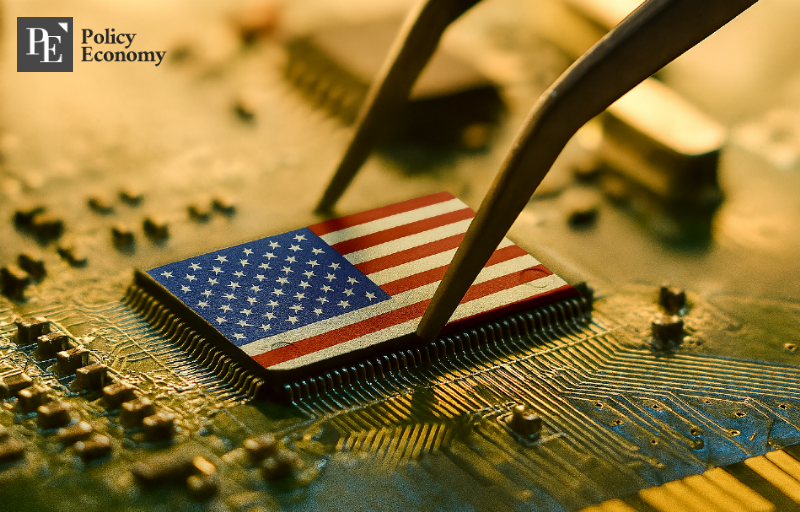U.S. and EU Forge ‘AI Chip Alliance,’ Institutionalizing a Trump-Style Containment Strategy Against China
Input
Modified
Consensus on the Need to Counter Beijing
AI Chip Alliance Architecture Taking Root
Global Supply Chain Splitting Into Rival Blocs

The United States and the European Union (EU) have formalized an alliance tying large-scale imports of artificial intelligence (AI) chips with the adoption of U.S. security standards. Until earlier this year, Europe had resisted Washington’s push for global export controls, but a series of developments—including China’s weaponization of rare earths—prompted a strategic pivot. Analysts now expect the supply chain bloc linking the U.S., Europe, South Korea, Japan, and Taiwan to become entrenched. The Trump administration has reinforced this outlook, institutionalizing its China containment strategy by combining increased budget allocations with tighter export restrictions under its AI Action Plan.
Europe’s Shift Traced to Trade Negotiations
On the 22nd, the South China Morning Post (SCMP) reported that Washington and Brussels have formed an “AI chip alliance” to coordinate more closely across technology, security, and commerce in an effort to counter China. Citing a joint statement released the previous day, the outlet noted that while Beijing was not explicitly mentioned, “many of the provisions were clearly aimed at China.” Specifically, the deal includes the EU’s purchase of $40 billion worth of AI chips from the U.S. and the adoption of American security standards to prevent sensitive technologies from reaching “destinations of concern.”
Maroš Šefčovič, the EU’s trade commissioner, stressed that the two sides would cooperate on investment screening and export controls to ensure advanced technologies such as semiconductors “do not fall into the wrong hands.” He described the agreement as a “standardized process for sensitive technologies,” adding: “When U.S. AI chips arrive in Europe, they will stay here, be used for the benefit of the European economy, and will not be re-exported elsewhere.”
This marks a stark departure from just a year or two ago. Under the Biden administration, Washington expanded export controls on advanced AI chips globally, prompting open complaints from Brussels that the EU, unlike South Korea and Japan, was excluded from carve-outs. German and French officials even accused the U.S. of building an “iron curtain” around AI and warned they might pursue cooperation with China if necessary. Until early this year, most in the diplomatic community assumed Europe would remain reluctant to join Washington’s anti-China coalition.
Two main developments triggered the turnaround. First, tariff reductions: The Trump administration recently capped additional duties on EU pharmaceuticals and semiconductors at 15% through trade negotiations, easing uncertainty for European exporters. Second, a growing recognition that failure to counter Beijing could expose Europe to even greater technological and security risks. China’s weaponization of rare earths and permanent magnets has been viewed as a direct threat to European industry, fueling consensus that “aligning with the U.S. is the safer defense.”
As a result, the EU has dropped its earlier resistance and joined hands with Washington. Analysts say the AI chip alliance goes well beyond a procurement deal, amounting instead to structural cooperation spanning supply chains, security, and trade. The U.S. benefits from a stronger export control network against China, while Europe gains greater stability for its tech ecosystem and market access amid the uncertainty of U.S.-China tensions.
U.S.-Europe-Asia Network Strengthens, Private Sector Cooperation Accelerates
Industry experts agree that the agreement cements the AI chip supply chain around the U.S., Europe, Japan, South Korea, and Taiwan. With Seoul, Tokyo, and Taipei already tightly integrated into U.S. production ecosystems, Europe’s participation effectively locks in a “trusted zone” for semiconductor supply. Washington is institutionalizing a multilateral architecture that excludes China, and with Europe now on board, the boundaries between blocs are becoming even clearer.
Private-sector cooperation is also accelerating. A prominent example is Samsung Electronics’ $165 billion foundry deal with Tesla. The eight-year agreement will see Samsung exclusively produce AI chips at its Taylor fab in Texas, a move widely seen as the private-sector version of the U.S.-Korea supply chain alliance. For a U.S. automaker to sign such a large contract with a Korean semiconductor company on the condition of U.S.-based production underscores the deepening of industrial and technological cooperation among allies.
Japan’s SoftBank recently joined in by investing $2 billion in Intel, describing the partnership as a “strategic alliance” encompassing not just equity stakes but also joint development of AI semiconductors and next-generation chip infrastructure. Such investments illustrate Washington’s blueprint of broadening its trusted semiconductor bloc by incorporating major Asian partners.
For allies like South Korea and Japan, Washington’s strategy brings both opportunities and burdens. On one hand, secure demand boosts technological credibility, investment, and employment. On the other, it constrains opportunities in the Chinese market and elevates regulatory risks. Tougher security and re-export restrictions set by the U.S. and EU will inevitably raise compliance costs and limit technology transfers. In effect, America’s AI package strategy narrows the independent options available to its allies.

Concerns Over Technology Bloc Formation
The Trump administration’s AI strategy is unfolding under the clear banner of countering China. In July, President Trump declared publicly that he would “never allow China to win the AI race,” equating technological supremacy with national security. The White House subsequently unveiled its AI Action Plan, which included tighter restrictions on exports of advanced semiconductors, a 30% increase in the federal AI budget, and the establishment of an integrated civil-military research system.
The measures are considerably tougher than those under the Biden administration, which expanded export controls incrementally. Trump’s team has applied restrictions globally, while simultaneously channeling $40 billion in subsidies into domestic semiconductor fabs and doubling the research and development tax credit rate from 20% to 40%. Analysts see this not as mere technology investment but as an effort to institutionalize a “de-China” supply chain.
Ultimately, the Trump administration’s moves appear aimed at reshaping the global industrial ecosystem itself. Experts caution, however, that while the strategy may yield short-term gains in allied investment and supply chain stability, it could also slow innovation by deepening technological bloc formation and geopolitical confrontation. In other words, Trump’s hardline stance may achieve its goal of containing China, but it could just as easily impose higher costs and uncertainty on the global industrial order.





















